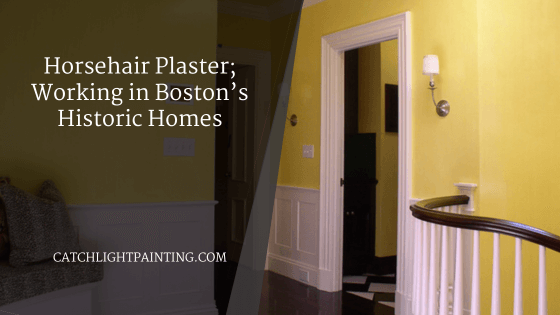Working in some of the country’s oldest neighborhoods is one of the most rewarding aspects of our work at Catchlight. Our team of talented painters has developed a unique set of skills that painting contractors in other regions of the nation simply do not need because, here, in the Greater Boston area, many homes have building features originating from the 17th, 18th, and 19th centuries.
The endless design and construction features in Boston Brownstones, Victorians, or Colonials are unlikely to be found west of the Mississippi, let alone outside New England. One such feature is horsehair plaster, which is found in many historic homes in Greater Boston.
Horsehair Plaster – What Is It and Why Was It Used?
Before the modern era of drywall (pre-1940s), interior walls and ceilings were constructed with lath and plaster, a building technique that was simple and effective but ultimately time-consuming. Lath is comprised of thin wooden strips nailed between the ceiling joists or wall studs; then, plaster is applied in multiple coats to form a solid surface. Plaster is applied to the lath in phases, allowing each coat to dry completely before adding another.
Like most inventions, horsehair plaster was born of necessity and inspiration; horses, with their copious amount of hair, were ubiquitous at the time, used for everything from transportation to farming to hauling. Reinforcing plaster with horsehair added strength, durability, and resistance to cracking, a common problem as houses settled. Now, horsehair plaster can be found all over the Greater Boston and New England region as homeowners choose to maintain its unique qualities.
Is It Difficult to Work With?
Working with horsehair plaster requires, first and foremost, knowledge as well as a skilled, steady hand. Repairing this type of plaster includes the use of plaster buttons, perforated discs the size of a quarter, screwed into the studs or joists to help reattach loose or ‘plaster that gives under pressure’; loose plaster is removed by vacuuming, then the exposed plaster must be wetted with water to prevent new patching material from absorbing too quickly into the original plaster. As usual, applying multiple thin coats of filler is preferred over a thickly applied filler. Finally, the experienced craftsman or woman will know to be cautious about creating and inhaling dust created during the prep phase since arsenic was used in the process of separating horse hair from the hide. We take pleasure in working on old homes, and this type of historic home painting and restoration work is our bread and butter! It is why Catchlight is often called upon to repair rather than replace walls with horsehair plaster’s unique characteristics.
Horsehair Plaster and Lead Paint Safety
Commonly used when lead paint was popular, we take a cautionary approach when working with horsehair plaster. Every Catchlight painter is lead-safe certified, following the strictest protocols to effectively limit our customers’ and employees’ exposure; this would include
state-of-the-art equipment like HEPA-filtered sanders, vacuums, and negative air machines.
Please contact us today if you have any questions regarding horsehair plaster, interior painting services, or our historic home restoration and painting services.



